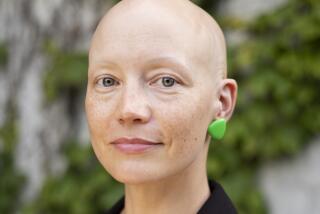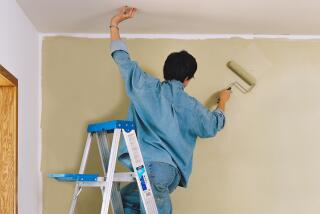A Big, Busy Family Avoids the Housework Blues With Easy Cleaning and Ingenuity : Immaculate Invention
- Share via
“He who messes it up cleans it up.”
That’s the household motto at the La Habra Heights home of Sandra and Reed Phillips. And it’s a good thing, too. Because with a family of 10, chaos might be the alternative.
But the Phillips family also has another ace in the hole when it comes to housecleaning. That ace is the house itself.
“We decided to build a home that would build housework out of our home,” Sandra Phillips says.
She helped design the 4,000-square-foot home. She served as her own contractor and supervised subcontractors.
And in the end, she got just what she needed--a five-bedroom house with low-maintenance materials and features that make housework easier.
For her guide and inspiration, she used a book, “Make Your House Do the Housework,” by Don Aslett and Laura Aslett Simons (Writer’s Digest Books, $9.95).
The house’s features include an automatic faucet, drinking fountain, electric hand dryer, built-in headboard that eliminates the need for clutter-collecting night stands and an easy-to-clean chandelier with flat prisms and smoked glass.
Other features are ceiling lights rather than lamps, suspended snack-bar seating that is easy to clean under, a down-draft cooktop that helps keep the kitchen stay cleaner, marble window sills, easy-care floor coverings that don’t show dirt and a central vacuum system.
“There’s no magic to anything we’ve done,” Phillips says. “There’s just incorporation of a lot of common sense type of things.”
Phillips first discovered Aslett and his cleaning theories in 1984, when she was pregnant with her eighth child. Even with a degree in home economics, she was beginning to feel overwhelmed.
Reading Aslett’s book “Clutter’s Last Stand” (Writers Digest Books, $9.95) convinced her that part of the problem was “that we had too much, that it could be organized more properly and that we needed to spend less time (on housework).”
Aslett’s ideas gave her “the courage to ‘de-junk,’ ” she says.
She and her family got rid of items they really didn’t need--like more than three changes of sheets for a bed.
Later, she attended one of Aslett’s seminars and read his “Is There Life After Housework?” (Writers Digest Books, $8.95). This book outlines “how to clean intelligently,” she says.
“So, if we can de-junk, organize that which we have left and then clean it intelligently, I felt that that would give us more time to be together as a family and it has done that,” Phillips says.
“The goal we have in our family is to do as little housework as possible and the kids don’t complain about that,” she says. But that doesn’t mean they don’t work.
The Phillips brood includes two girls aged 12 and 7 and four boys aged 9, 10, 14 and 17 at home. Two sons--aged 19 and 21--are away at college. All the children at home have assigned chores. A valued rite of passage is that high school seniors in the family are absolved of dishwashing responsibility.
“It isn’t always perfect and sometimes we don’t get everything done,” she says “but we get the important things done each day.”
Phillips considers those important things to be the dishes, the laundry and making all the beds.
How does the house help with all of this?
It’s simple, Phillips says. Much of her house is based on one of Aslett’s major principles: “Avoid high-maintenance materials.”
For instance, floor coverings can be a high-maintenance item, but not in the Phillips’ house. The entry floor is covered with gray-toned marble tile with dark grout and swirls of peach and salmon colors. Marble is durable and easy to maintain, requiring only a little damp mopping, and the colors don’t show dirt easily.
The kitchen floor is sheet-vinyl in a speckled gray pattern. Phillips chose the smoothest finish she could find, because the indentations common to vinyl trap dirt and make floors harder to clean.
Phillips doesn’t believe in waxing floors--one point she differs on with Aslett. She says just a little damp mopping keeps her floors looking clean enough.
As to the mopping, that’s where the kids come in. Since the family style is to go barefoot--leaving shoes at the door to cut down on tracked-in dirt--the kids do the mopping with their bare feet.
It’s easy and fun, Phillips says. This requires a couple of damp cloths (old towels work best), a spray bottle with water mixed with a little all-purpose liquid cleaner and, of course, willing feet. They spray a little cleaner here and there on the floor and skate-mop across the floor.
Carpets aren’t a problem either.
Phillips selected a medium-gray tweed carpet in a Berber weave.
“Anytime you have a tweed . . . it’s more forgiving because you don’t see as many spots and sprinkles in it,” she says. The varied height also camouflages and “camouflage whenever you can” is another Aslett principle.
As a result, Phillips’ carpet only needs vacuuming once a week and that’s easy, too, because of the central vacuum system.
However, she did choose a dense plush carpet in a medium gray for her husband’s office, the music room and the master bedroom, because they are not high-traffic areas and won’t get dirty as fast.
And then there are the window sills.
Dusting window sills made of painted drywall can be frustrating, because after a while, the dust and dirt just seem to sort of stay there.
Phillips’ solution was to purchase 92 feet of white slab marble for about $300. She then had a piece cut for each window sill in the house. Now, her window sills are beautiful and wipe clean in the blink of an eye.
Several of the unique items in the Phillips home were fairly inexpensive.
The kitchen drinking fountain, which filters and cools the water, cost about $250 and paid for itself in six months. Bottled water for the family was costing $30 to $40 a month and there was the cost of paper cups. Now there are no paper cups to throw away and fewer glasses to wash, which saves money and water.
In what Phillips calls her “magic bathroom” is a wall-mounted, electric hand dryer that cost about $150 and is low-voltage. Time, money and water are saved by not having to wash towels for that bathroom.
The same bathroom has an automatic faucet. Put your hand under the faucet and warm water comes out. Remove your hand and the water shuts off. There are no handles to drip water on and that tough job of cleaning around the bottoms of faucets has been eliminated.
This bathroom also has a wall-mounted soap dispenser, eliminating another source of mess.
The downstairs baths have wall-mounted toilets, which eliminate the underneath pedestal that’s difficult to keep clean. The weight of the toilets requires that they be attached to the foundation for safety. That’s why Phillips was unable to have them installed in her upstairs bathrooms.
Features in other bathrooms include a manufactured shower in the shape of a nautilus shell. The 30-inch-diameter shower of rigid acrylic is designed so that no water splashes out and there is no need for a shower door (always a tough cleaning job) or curtain.
The master bath contains an easy-to-clean imitation marble custom tub and a separate shower. The floor is a medium-gray ceramic tile with dark grout.
In the master bedroom, a built-in headboard hides controls for a security system, reading lights, a phone, a flashlight and controls for a television, which is in a cut-out area in the wall, rather than on a table. The light source is attached to the ceiling fan.
There are no lamps or bedside tables in the master bedroom, which cuts down on dusting tasks and general clutter.
Perhaps the most wonderful example of organization in the Phillips home is the laundry room, which is about 100 square feet and arranged in a U-shape.
There are three doors on one side of the room. Behind those doors are laundry bins. The laundry bins are at the bottom of chutes located behind wooden panels at the landing of the home’s rear stairway. Upstairs, members of the Phillips family drop dirty clothes into chutes marked: light, medium and dark.
The dirty clothes are removed from the laundry bins to be treated for spots at the sink. Next, clothes go into the washer and then the dryer. The room has shelves and space for folding and hanging clothes. There’s even an ironing board that folds back into the wall and a sewing machine for mending.
But even with all this organization, Sandra Phillips says, “I feel like it takes all my intelligence, which I may have been given in this life, to keep this household running.”
But she also says: “I never feel like anything I do is more fulfilling and more important than keeping the home organized, with the help of the children. I don’t do it for them. I do it with them.”


